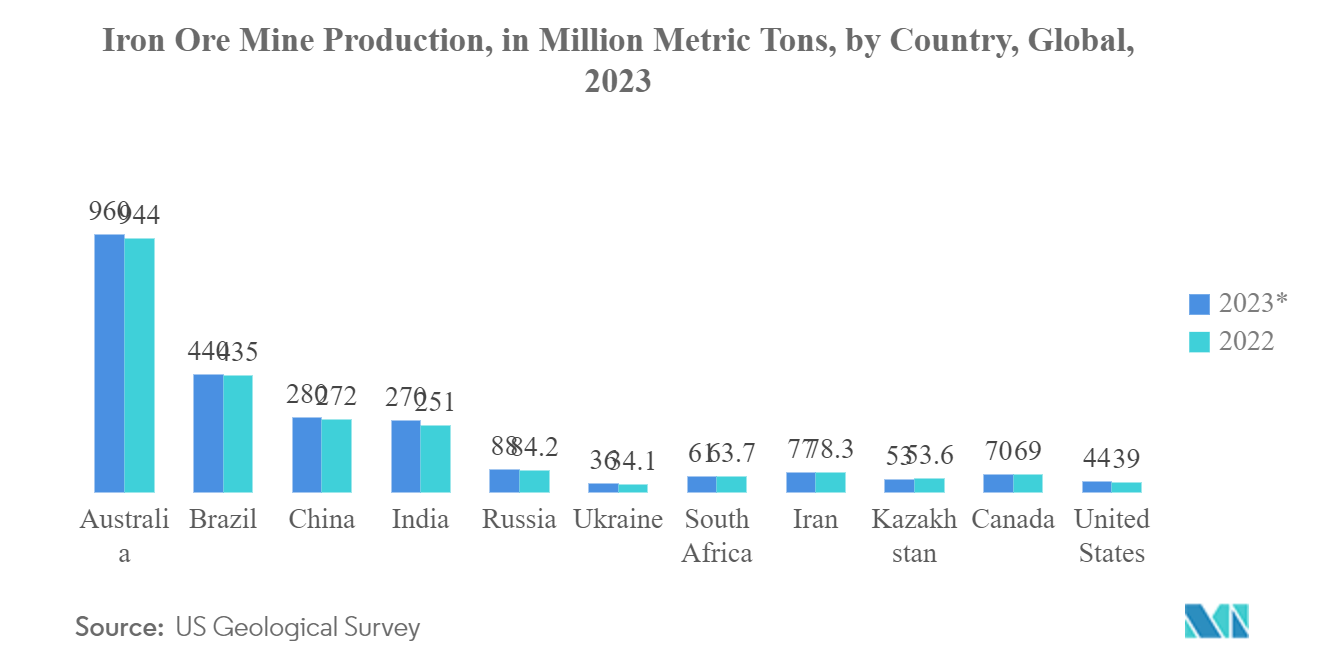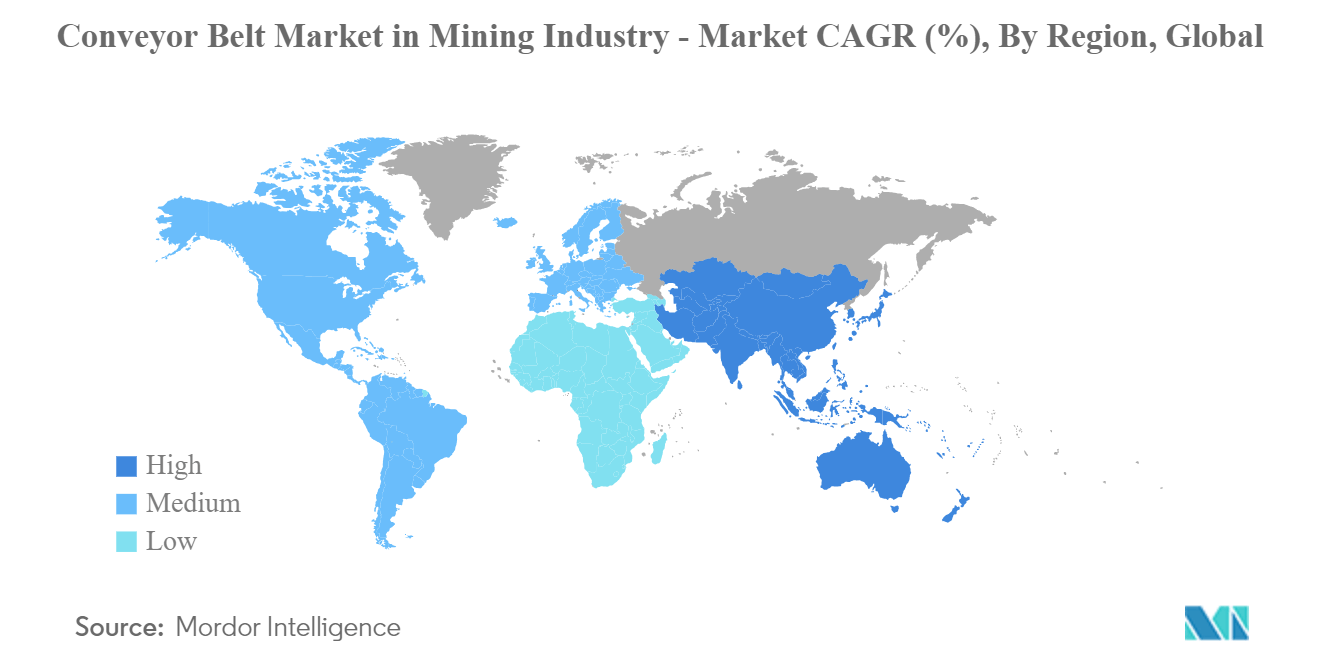Market Trends of Conveyor Belt Industry In Mining Industry
Textile Reinforced to Drive the Market's Growth
- Conveyor belts with textile reinforcement are typically used for abrasive and heavy-duty goods. They are a more affordable alternative to steel cord belts for shorter transporting distances and lesser capacities. For most sectors like mining, mineral processing, and quarrying, the textile-reinforced conveyor belt is excellent. It can be blended with many different qualities, such as covers that are grease, abrasion, heat, impact, and fire resistant.
- The internal structure of a textile or fabric belt carcass consists of a single or multi-layered series of synthetic fabric layers interlaced between rubber-based shock-absorbent layers. The top and bottom sides of the belt consist of hard-wearing, abrasion, and cut-resistant rubber covers. The covers protect the belt from damage, especially at the loading points of the conveyor. This provides the tensile strength to the conveyor belt used in the mining industry.
- The strength, extension, and flexibility of synthetic fibers used in technical woven fabrics are higher than natural fibers used earlier. The primary fibers are cotton, viscose rayon, nylon, polyester, glass, and aramid. The aramid tenacity is seven times that of steel, and aramid is lighter than steel. It resists temperatures of 400-500 ºC, dampness, and chemicals and has high abrasion resistance. Thus, it is used in mining conveyor belts.
- Their strength significantly influences the carrying capacity and operating safety of conveyor belts in the mining industry. Thus, materials like textile-reinforced conveyor belts are anticipated to become more prevalent to boost the conveyor belt's strength.
- The belting manufacturers also supply tables for fabric belting, reflecting the number of plies proposed for a belt based on the different types and grades of materials to be transported on the belt. The fabric material is better than steel reinforcement in conveyor belts as textiles make it much more flexible, energy-efficient, corrosion-resistant, high-strength, and lightweight. With the rising Mining activities across several regions and the increase in investments in the Mining industry, the need for Textile reinforced type conveyor belts is expected to rise.
- Australia and Brazil, which produced 880 million metric tons and 410 million metric tons of iron ore, respectively, in 2022, are among the countries with the highest production rates. In Australia, mines produced over 880 million metric tons of useable iron ore in 2022. Additionally, several locations are seeing a variety of developments in the mining industry, which is anticipated to increase demand for certain types of conveyor belts, such as the Textile Reinforced type, due to its extensive features.
- Also, belt materials and their properties have undergone considerable changes over the past years. The growing need for increased tensile properties, abrasion resistance, and higher economy has encouraged belt users to collaborate with belting manufacturers and plane engineers to develop tougher and more economical conveyor belting.

North America is Expected to Hold Significant Market Share
- The North American region has been a prominent market for conveyor belts owing to their continued adoption across the industry. The growth of conveyor belts has been dependent on the inherent demand for mining in the region. According to BEA, the United States GDP increased by around 7% in 2022 when measured in chained 2012 U.S. dollars compared to the previous year. The value added to GDP by the mining sector increased by the largest at 51.7%.
- U.S. Geological Survey estimated that U.S. mines produced non-fuel mineral commodities worth over USD 98.2 billion in 2022, an increase of about USD 3.6 billion above the 2021 revised total of USD 94.6 billion. As a result of increased mining activities, the conveyor belt market is projected to experience significant demand from the mining industry in the future years.
- In the United States, government support for mining through presidential orders, such as for essential minerals development or regulatory changes, has assisted the business. Despite this, the government is also investing in mining activities that produce market demand. For example, in April 2023, as part of President Biden's Investing in America plan, the U.S. Department of Energy (DOE) announced up to USD 450 million from the Bipartisan Infrastructure Law to develop clean energy demonstration projects on existing and former mine lands.
- Moreover, the demand for the market is anticipated to grow significantly throughout the study period as a result of the increased investments in the region's mining sector. For instance, the Anglo-Australian mining corporation Rio Tinto declared in June 2023 that it intended to invest USD 920 million at its Kennecott facility in Utah, U.S., to increase its supply of copper. In addition to open-cut operations, Rio Tinto anticipates the NRS to produce a further 250,000 tonnes of copper over the following ten years. Production is expected to begin in 2024.
- Canada is home to one of the most active mining industries in the world. According to the Mining Association of Canada, the country ranks in the top five members involved in producing 13 major minerals and metals, including uranium, nickel, potash, cobalt, aluminum, diamonds, titanium, and gold.
- The mining sector in Canada is one of the biggest in the world. According to the Canadian government, Canada produced 60 minerals and metals at 6,500 sand, gravel, and stone quarries and over 200 mines. In 2021, Canada's mining production was worth USD 55.5 billion. Additionally, Canada approved spending roughly 3.8 billion Canadian dollars (USD 2.8 billion) on a crucial minerals plan through 2030. Such government investments will strengthen the mining sector in the area, necessitating the use of conveyor belts due to their widespread application.

